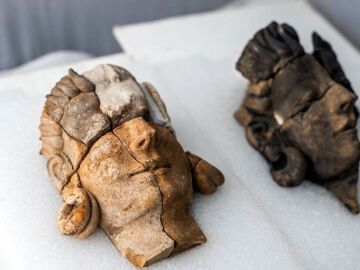
The work carried out within the framework of the V excavation campaign in the tartessian site of Turunuelo Houseslocated in the Badajoz municipality of Guareña, have brought to light the first figured reliefs belonging to the Tartessian culture (VIII-IV centuries BC). The finding, which dates from the 5th century BC, represents a profound paradigm shift in the interpretation of Tartesus, traditionally considered an aniconic culture for representing divinity through animal or plant motifs, or through betilos (sacred stones).
The team from the Institute of Archaeology, a joint center of the Higher Council for Scientific Research (CSIC) and the Junta de Extremadura, led by Esther Rodríguez González and Sebastián Celestino Pérez, confirmed this Tuesday at a press conference that, of the set recovered to date , two of the figured reliefs are almost complete and correspond to female figures adorned with outstanding earrings or earrings that represent typical pieces of Tartessian goldsmithing.
Until now, these gold pieces were only known through discoveries made in enclaves such as the Cancho Roano site or within the set that makes up the Aliseda treasure, a Tartessian funerary trousseau found in Cáceres. Given the technical quality and the artistic detail with which they were made, it could be before the representation of two feminine divinities of the Tartessian pantheon, although, however, the researchers do not rule out that they are prominent figures of Tartessian society, the CSIC reported in a press release.
Together with the two female figures, they have recovered other relief fragments. These belong to at least three other individuals, one of them identified as a warrior by preserving part of the helmet. Thus, the finding does nothing but influence even more both the importance of the site and the importance of the Tartessian culture in the Guadiana valley during its last moments.
Source: Lasexta
Bruce is a talented author and journalist with a passion for entertainment . He currently works as a writer at the 247 News Agency, where he has established himself as a respected voice in the industry.












